BEST PRICE
GUARANTEED
BEST PRICE
GUARANTEED
A perfect destination for those who want to combine vibrant culture, exceptional architecture,
magnificent beaches and nightlife. Barcelona is all that and much more.


There are several buses that will take you from the airport and drop you off a few feet from our apartments.
The Aerobus is the express busthat connects theairport with the centre of Barcelona every five minutes, 365 days a year.
Within around 30 minutes you can go to or return from theairport terminals (T1 or T2) comfortably and economically, without having to change transport,
and youare dropped off a few feet from our apartments inthe central Plaça d’Espanya (ask the driver about the stop).
They areseveral buses that travel from the airport to within a few feet from our apartments.
They are light and dark blue and have the word “Aerobus” written below on the side in round letters,
but when you go back to the airport you must make sure you get the Aerobus that takes you to the rightterminal.
If you are not sure ask the driver. The journey costs €5.30.

The other buses you can take to get to and from the airport are the Airport buses number 46 of TMB and the night bus N17 (bus company MOHN).
These buses are cheaper, albeit slower, less frequentand have less baggage space. They also drop you off a few feet from our apartments on Plaça d’Espanya.

A taxi is another easy and comfortable way to travel from Barcelona Airport to any destination in the city.
The taxi fareis usually around €25

If you prefer comfort and speed, we have a private transfer service between the airport and the apartments,
at a cost of €60 for 1-4 persons (or €100 return). If there are 5 to 7 persons,
the cost of the transfer is €70 (or €125 return).


The Magic Fountain of Montjuïc (Catalan: Font màgica de Montjuïc) is a fountain located at the head of Avenida Maria Cristina in the Montjuïc, five minutes walk from our apartments. The fountain is situated below the Palau Nacional on the Montjuïc hill and near the Plaza Espanya.
The fountain, like most of the surrounding developments, was constructed for the 1929 Barcelona International Exposition.
The Magic Fountain was designed by Carles Buigas, who had designed illuminated fountains as early as 1922. The site where the fountain was constructed was the previous location of The Four Columns. The columns, representative of the Catalanism movement, were demolished in 1928 under the rule of Prime Minister Migel Primo de Rivera and were re-erected in 2010 a few meters away from the original location.
Buigas submitted his design a year before the exhibition, with many calling the plan too ambitious, with too little time to complete. The construction project utilized over 3000 workers. The first show took place on May 19, 1929, the day before the start of the Exposition. The fountain was badly damaged in the Spanish Civil War and did not operate until 1955, after Buigas oversaw needed repairs.
In the 1980s, music was incorporated with the light show and the fountain, along with the Museu Nacional, was completely restored prior to the 1992 Summer Olympics, held at Montjuïc.
The magic fountain becomes a show at the time when 29 water games begin harmonious blend together to the beat of the music. The water seems to come alive when it starts to draw shapes and unexpected movements are combined with color and light, being able to create emotions and feelings. Converted into an icon of the city of Barcelona, and located right next to our apartments is a show worth seeing and living, that excites all presents, tourists and locals.
The Magic Fountain has choreographed music lasting 10 to 14 minutes combining musical fragments.
During the season of spring-summer 2013, from Thursday to Sunday, from 21:00 to 23:30, at the Magic Fountain sound great successes of 2012 remix music nineties, operettas, classical music, songs of the eighties soundtracks comics, Disney music, movie soundtracks , Spanish classical music and the singing of the flag, among others.

The Palau Nacional, situated in Montjuïc (Barcelona), few minutes walk of our apartments, is a palace constructed between the years 1926 and 1929 for the 1929 International Exhibition in Barcelona. Since 1934 it has been home to the National Art Museum of Catalonia, important to visit.
It was the main building of the exhibition, realised by Eugenio Cendoya and Eugene Henry Catà under the supervision of Pere Domènech i Roura, which disregarded the initial project proposed by Puig i Cadafalch and Guillermo Busquets. The Palace has a ground surface of 32,000 m² and is constructed in a classic style of architecture inspired by the Spanish Renaissance. It has a rectangular floor plan flanked by two side and one rear square sections, with an elliptical dome covering its central part. The fountains located by the staircases leading to the palace are the work of Carles Buïgas. The palace’s Oval Room was host to the opening ceremony of the Exhibition, presided by Alfons XIII and Queen Victòria Eugènia.
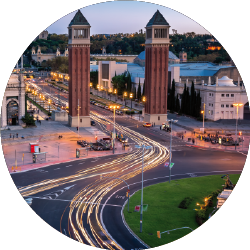
Plaza España is one of Barcelona is most important squares, five minutes walk of our apartments, built on the occasion of the 1929 International Exhibition, and realised by Josep Puig i Cadafalch, Guillem Busquets and Antoni Darder.
One of the city is biggest squares, at the foot of Montjuïc, where we find the trade fair and the National Art Museum of Catalonia. Other important buildings in the square are the Arenas Shopping Centre (old bullring), the Plaza Hotel and the Venetian Towels, the work of Ramon Reventós, built for the 1929 Exhibition.

CaixaForum Barcelona is an art gallery sponsored by "la Caixa", and opened in 2002 in a former factory. CaixaForum is located in the Montjuïc area, on Avinguda de Francesc Ferrer i Guàrdia, near our apartments.
The museum houses art exhibits and is free to the public. The building was originally commissioned as a textile factory by Casimir Casaramona i Puigcercós, and built by the famous Catalan architect Josep Puig i Cadafalch.
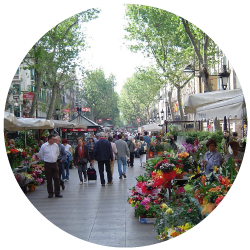
Located three metro stops away from our apartments, La Rambla is a street in central Barcelona, popular with tourists and locals alike. A tree-lined pedestrian mall, it stretches for 1.2 kilometers between Barri Gòtic and El Raval, connecting Plaça de Catalunya in the centre with the Christopher Columbus Monument at Port Vell.
La Rambla can be considered a series of shorter streets, each differently named, hence the plural form Les Rambles (the original Catalan form; in Spanish it is Las Ramblas). From Plaça de Catalunya toward the harbour, the street is successively called:
Construction of the Maremàgnum in the early 1990s resulted in a continuation of La Rambla on a wooden walkway into the harbour called the Rambla de Mar. Nearby is the Maritime Museum (Museu Marítim), specifically devoted to naval history in the Mediterranean, which displays a full-scale replica of an ancient galley battle. The museum is housed in the Royal Dockyards (in Catalan, Drassanes) of the medieval era where the ships that connected the extensive dominions of the Crown of Aragon with other ports of the Mediterranean were built. The old port offers other attractions such as leisure venues, restaurants, an IMAX theater, and an aquarium. In the historical center, close to La Rambla, may be found the Cathedral of Santa Eulàlia, the recently restored (1968–72) Gothic cathedral and seat of the Archbishop of Barcelona, the Plaça Sant Jaume that houses the buildings of the Generalitat of Catalonia and Barcelona’s City Council, as well as the narrow streets of the Gothic quarter, the Raval and the Born area. The promenade is crowded during the day and until late in the night. It is full of kiosks that sell newspapers and souvenirs, flowers and birds, street performers, cafes, restaurants and shops. Near the port are found smaller local markets and the shop-fronts of painters and draftsmen. Strolling along La Rambla one can see such historic buildings as the Palace of the Virreina and La Boqueria market and the famous Liceu Theatre (Liceo in Spanish), in which operas and ballets are staged. One of the side streets, only a few metres long, leads to the Royal Square (Plaça Reial), a plaza with palm trees and porticoed buildings containing many pubs and restaurants, and in which stamp and coin collectors gather on the weekends. La Rambla can be crowded, especially during the height of the tourist season. Most of the time there are many more tourists than locals occupying the Rambla, which fact has changed the shopping selection, as well as the character of the street in general.
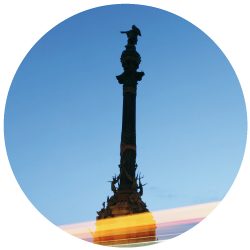
The Columbus Monument, three metro stops away from our apartments, is a 60 m (197 ft) tall monument to Christopher Columbus at the lower end of La Rambla, Barcelona, Catalonia, Spain. It was constructed for the Exposició Universal de Barcelona (1888) in honor to Columbus first voyage to the Americas. The monument serves as a reminder that Christopher Columbus reported to Queen Isabella I and King Ferdinand V in Barcelona after his first trip to the new continent.
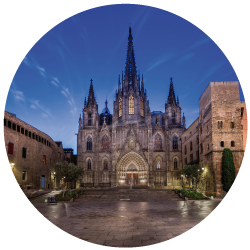
The Cathedral of the Holy Cross and Saint Eulalia (Catalan: Catedral de la Santa Creu i Santa Eulàlia), also known as Barcelona Cathedral, located four metro stops away from our apartments, is the Gothic cathedral and seat of the Archbishop of Barcelona. The cathedral was constructed from the 13th to 15th centuries, with the principal work done in the 14th century. The cloister, which encloses the Well of the Geese (Font de les Oques) was completed in 1448. In the late 19th century, the neo-Gothic façade was constructed over the nondescript exterior that was common to Catalan churches. The roof is notable for its gargoyles, featuring a wide range of animals, both domestic and mythical.
It is a hall church, vaulted over five aisles, the outer two divided into chapels. The transept is truncated. The east end is a chevet of nine radiating chapels connected by an ambulatory. The high altar is raised, allowing a clear view into the crypt.
The cathedral is dedicated to Eulalia of Barcelona, co-patron saint of Barcelona, a young virgin who, according to Catholic tradition, suffered martyrdom during Roman times in the city. One story says that she was exposed naked in the public square and a miraculous snowfall in mid-spring covered her nudity. The enraged Romans put her into a barrel with knives stuck into it and rolled it down a street (according to tradition, the one now called Baixada de Santa Eulàlia). The body of Saint Eulalia is entombed in the cathedral is crypt.
One side chapel is dedicated to Christ of Lepanto, and contains a cross from a ship that fought at the Battle of Lepanto (1571). Catalan legend states that during the battle, the corpus suddenly and miraculously shifted to the right to avoid being hit by a cannonball, a miraculous sign from God that the Ottomans would be defeated. The chapel of Christ of Lepanto also contains the shrine and sepulchre of Saint Olegarius, who was a Bishop of Barcelona and an Archbishop of Tarragona.
The cathedral has a secluded Gothic cloister where 13 white geese are kept, the number explained by the assertion that Eulalia was 13 when she was martyred.
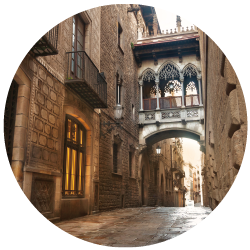
The Gothic Quarter (Catalan: Barri Gòtic), located four metro stops away from our apartments, is the centre of the old city of Barcelona. It stretches from La Rambla to Via Laietana, and from the Mediterranean seafront to Ronda de Sant Pere.
Despite several changes undergone in the 19th and early 20th century, many of the buildings date from Medieval times, some from as far back as the Roman settlement of Barcelona. Remains of the squared Roman Wall can be seen around Tapineria and Sots-Tinent Navarro to the north, Avinguda de la Catedral and Plaça Nova to the west and Carrer de la Palla to the south. El Call, the medieval Jewish quarter, is located within this area too.
The Barri Gòtic retains a labyrinthine street plan, with many small streets opening out into squares. Most of the quarter is closed to regular traffic although open to service vehicles and taxis.
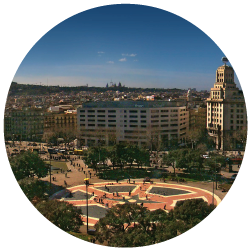
Plaça de Catalunya, meaning in English "Catalonia Square, located three metro stops away from our apartments, is a large square in central Barcelona that is generally considered to be both its city centre and the place where the old city (see Barri Gòtic and Raval, in Ciutat Vella) and the 19th century-built Eixample meet.
Some of the city is most important streets and avenues meet at Plaça Catalunya: Passeig de Gràcia, Rambla de Catalunya, La Rambla or Portal de l Àngel, in addition to Ronda de Sant Pere, Carrer de Vergara or Carrer de Pelai. The plaza occupies an area of about 50,000 square metres. It is especially known for its fountains and statues, its proximity to some of Barcelona is most popular attractions, and for the flocks of pigeons that gather in the centre.
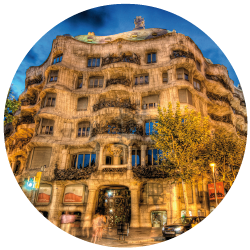
Casa Milà, located six metro stops away from our apartments, and better known as La Pedrera (meaning the The Quarry), is a building designed by the Catalan architect Antoni Gaudí and built during the years 1906–1912. It is located at 92, Passeig de Gràcia (passeig is Catalan for promenade) in the Eixample district of Barcelona, Catalonia, Spain.
It was a controversial design at the time for the bold forms of the undulating stone facade and wrought iron decoration of the balconies and windows, designed largely by Josep Maria Jujol, who also created some of the plaster ceilings. The building did not respect the rules of conventional style, which made it the subject of criticism. The nickname "La Pedrera" was assigned by citizens who disapproved of its heterodoxy.
Architecturally it is considered an innovative work for its steel structure and curtain walls – the façade is self-supporting. Other innovative elements were the construction of underground car parking and separate lifts and stairs for the owners and their servants.
The building is 1,323 m2 per floor on a plot of 1,620 m2. Gaudí began the first sketches in his workshop in the Sagrada Familia, where he conceived of this house as a constant curve, both outside and inside, incorporating multiple solutions of formal geometry and elements of a naturalistic nature.
One of the most significant parts of the building is the roof, crowned with skylights or staircase exits, fans, and chimneys. All of these elements, constructed with timbrel coated with limestone, broken marble or glass, have a specific architectural function, nevertheless, they have become real sculptures integrated into the building.
In 1984, it was declared a World Heritage site by UNESCO. The building is made open to the public by the CatalunyaCaixa Foundation, which manages the various exhibitions and activities and visits to the interior and roof.
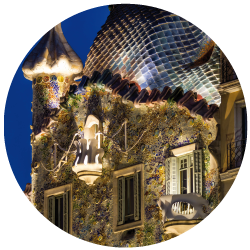
Casa Batlló, located six metro stops away from our apartments, is a renowned building located in the heart of Barcelona and is one of Antoni Gaudí’s masterpieces. Casa Batlló is a remodel of a previously built house. It was redesigned in 1904 by Gaudí and has been refurbished several times after that. Casa Batlló evokes the creativity and playfulness of Gaudí’s work through the incrassate facades and creative floors. Gaudí is assistants Domènec Sugrañes i Gras, Josep Canaleta and Joan Rubió also contributed to the renovation project.
The local name for the building is Casa dels ossos (House of Bones), as it has a visceral, skeletal organic quality. It was originally designed for a middle-class family and situated in a prosperous district of Barcelona.
The building looks very remarkable — like everything Gaudí designed, only identifiable as Modernisme or Art Nouveau in the broadest sense. The ground floor, in particular, is rather astonishing with tracery, irregular oval windows and flowing sculpted stone work.
It seems that the goal of the designer was to avoid straight lines completely. Much of the façade is decorated with a mosaic made of broken ceramic tiles (trencadís) that starts in shades of golden orange moving into greenish blues. The roof is arched and was likened to the back of a dragon or dinosaur. A common theory about the building is that the rounded feature to the left of centre, terminating at the top in a turret and cross, represents the lance of Saint George (patron saint of Catalonia, Gaudí is home), which has been plunged into the back of the dragon.
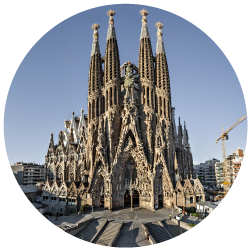
The Basílica i Temple Expiatori de la Sagrada Família (English: Basilica and Expiatory Church of the Holy Family), commonly known as the Sagrada Família, located seven metro stops away from our apartments, is a large Roman Catholic church designed by Catalan architect Antoni Gaudí (1852–1926). Although incomplete, the church is a UNESCO World Heritage Site and in November 2010 was consecrated and proclaimed a minor basilica by Pope Benedict XVI. It is incorrect to refer to it as a cathedral as it is not the seat of a bishop. Though construction of Sagrada Família had commenced in 1882, Gaudí became involved in 1883, taking over the project and transforming it with his architectural and engineering style—combining Gothic and curvilinear Art Nouveau forms.
Gaudí is original design calls for a total of eighteen spires, representing in ascending order of height the Twelve Apostles, the four Evangelists, the Virgin Mary and, tallest of all, Jesus Christ. Eight spires have been built as of 2010, corresponding to four apostles at the Nativity façade and four apostles at the Passion façade. The Evangelists spires will be surmounted by sculptures of their traditional symbols: a bull (Saint Luke), a winged man (Saint Matthew), an eagle (Saint John), and a lion (Saint Mark). The central spire of Jesus Christ is to be surmounted by a giant cross; the spire is total height (170 metres (560 ft)) will be one metre less than that of Montjuïc hill in Barcelona as Gaudí believed that his creation should not surpass God is. The lower spires are surmounted by communion hosts with sheaves of wheat and chalices with bunches of grapes, representing the Eucharist. The completion of the spires will make Sagrada Família the tallest church building in the world.
The Church will have three grand façades: the Nativity façade to the East, the Passion façade to the West, and the Glory façade to the South (yet to be completed). The Nativity Façade was built before work was interrupted in 1935 and bears the most direct Gaudí influence. The Passion façade is especially striking for its spare, gaunt, tormented characters, including emaciated figures of Christ being scourged at the pillar; and Christ on the Cross. These controversial designs are the work of Josep Maria Subirachs. The Glory façade, on which construction began in 2002, will be the largest and most monumental of the three and will represent one is ascension to God. It will also depict various scenes such as Hell, Purgatory, and will include elements such as the Seven Deadly Sins and the Seven Heavenly Virtues.
Gaudí devoted his last years to the project, and at the time of his death at age 73 in 1926, less than a quarter of the project was complete. Sagrada Família is construction progressed slowly, as it relied on private donations and was interrupted by the Spanish Civil War—only to resume intermittent progress in the 1950s. Construction passed the midpoint in 2010 with some of the project is greatest challenges remaining and an anticipated completion date of 2026—the centennial of Gaudí is death Describing Sagrada Família, art critic Rainer Zerbst said "it is probably impossible to find a church building anything like it in the entire history of art" and Paul Goldberger called it "the most extraordinary personal interpretation of Gothic architecture since the Middle Ages."
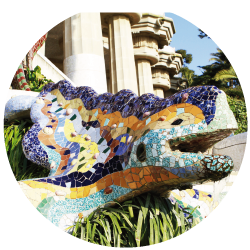
Park Güell (Catalan: Parc Güell) is a garden complex with architectural elements situated on the hill of El Carmel in the Gràcia district, nine metro stops away from our apartments. It was designed by the Catalan architect Antoni Gaudí and built in the years 1900 to 1914. It has an extension of 17.18 ha (0.1718 km²), which makes it one of the largest architectural works in south Europe. It is part of the UNESCO World Heritage Site "Works of Antoni Gaudí".
The park was originally part of a commercially unsuccessful housing site, the idea of Count Eusebi Güell, after whom the park was named. It was inspired by the English garden city movement; hence the original English name Park (in the Catalan language spoken in Catalonia where Barcelona is located, the word for "Park" is "Parc", and the name of the place is "Parc Güell" in its original language). The site was a rocky hill with little vegetation and few trees, called Muntanya Pelada (Bare Mountain). It already included a large country house called Larrard House or Muntaner de Dalt House, and was next to a neighborhood of upper class houses called La Salut (The Health). The intention was to exploit the fresh air (well away from smoky factories) and beautiful views from the site, with sixty triangular lots being provided for luxury houses. Count Eusebi Güell added to the prestige of the development by moving in 1906 to live in Larrard House. Ultimately, only two houses were built, neither designed by Gaudí. One was intended to be a show house, but on being completed in 1904 was put up for sale, and as no buyers came forward, Gaudí, at Güell is suggestion, bought it with his savings and moved in with his family and his father in 1906. This house, where Gaudí lived from 1906 to 1926, was built by Francesc Berenguer in 1904. It contains original works by Gaudí and several of his collaborators. It is now the Gaudi House Museum (Casa Museu Gaudí) since 1963. In 1969 it was declared a historical artistic monument of national interest.
It has since been converted into a municipal garden. Park Güell is skillfully designed and composed to bring the peace and calm that one would expect from a park. The buildings flanking the entrance, though very original and remarkable with fantastically shaped roofs with unusual pinnacles, fit in well with the use of the park as pleasure gardens and seem relatively inconspicuous in the landscape when one considers the flamboyance of other buildings designed by Gaudí.
The focal point of the park is the main terrace, surrounded by a long bench in the form of a sea serpent. The curves of the serpent bench form a number of enclaves, creating a more social atmosphere. Gaudí incorporated many motifs of Catalan nationalism, and elements from religious mysticism and ancient poetry, into the Park.
Roadways around the park to service the intended houses were designed by Gaudí as structures jutting out from the steep hillside or running on viaducts, with separate footpaths in arcades formed under these structures. This minimized the intrusion of the roads, and Gaudí designed them using local stone in a way that integrates them closely into the landscape. His structures echo natural forms, with columns like tree trunks supporting branching vaulting under the roadway, and the curves of vaulting and alignment of sloping columns designed in a similar way to his Church of Colònia Güell so that the inverted catenary arch shapes form perfect compression structures.
The large cross at the Park is high-point offers the most complete view of Barcelona and the bay. It is possible to view the main city in panorama, with the Sagrada Família and the Montjuïc area visible at a distance.

Camp Nou, often referred to in English as The Nou Camp is a football stadium which has been the home of Futbol Club Barcelona since 1957, located six metro stops away from our apartments.
The Camp Nou seats 99,786,reduced to 96,336 in matches organized by UEFA, making it the largest stadium in Europe and the 13th largest in the world in terms of capacity. It has hosted numerous international matches at a senior level, including two UEFA Champions League finals and the football competition at the 1992 Summer Olympics.
Camp Nou has been used for various purposes other than football, often hosting major concerts. Pope John Paul II celebrated mass for a congregation of over 121,000 at Camp Nou on 17 November 1982, on the occasion being made an honorary citizen of Barcelona. On 1 July 2009 the stadium held the launch of the U2 360° Tour, which was attended to the maximum capacity of 90,000 people. The lead singer of U2, Bono, explained that they had started their tour in Camp Nou since “This is where we wanted to build a space station, designed by Gaudi in the capital of surrealism." The concert ended with Bono wearing an FC Barcelona jersey. On 9 August 1988, Michael Jackson appeared at the stadium in front of 95,000 fans during his Bad World Tour.
VER MAPA
GPS 41.5325093º N 2.4448769º E
Carrer de Sant Fructuós, 37 - 08004 Barcelona T. (+34) 932 750 423 info@hometohomebarcelona.com

Everything. Very helpful, friendly welcome after the booking was made, and on arrival in Barcelona.
The apartment was comfortable, large, quiet and well equipped. Excellent bed, cooking corner, balcony, bathroom and shower.
Very good value for money. Location is 8 mins walking from Plaza de Espanya, with lots of restaurant and bars there.
At the Plaza are metro lines 1 and 3 and buses to Estacion de Sants, buses, and you can walk directly up to Montjuic for the big art museum, gardens and castle.
It is also very convenient that the airport buses (either Aerobus or city bus 46) stop at Plaza de Espana. 100% recommended
Комфортабельные апартаменты со всем необходимым, включая посудомойку и стиралку. Замечательный личный просторный сад в восточном стиле, в котором было приятно немного отодхнуть вечером после целого дня впечатлений.
В апартаментах на первом этаже очень тихо и спокойно. Все окна выходят во двор. Удачное расположение. Остались очень довольны!
I loved the modern contemporary furnishing in the apartment. The layout was perfect to make comfortable use of a small space. It felt bigger than it was. Many shops close by for food shopping, mall just 3 blocks away. One block of the main street when you will find Bus, Taxi and metro. The bed was awesome (wish I could take it with me). The kitchen is fully equipment with all your basic needs. Includes washing machine and dishwasher. I can't say enough good things about this place.
We had a great vacation in barcelona and one of the reasons was the home to home apartment which we chose to stay in. we enjoyed our staing at the apartment very much!!!
The staff was very professional and kind, the location was great only five minutes from the magic fountain.
The apartment is modern and very clean we recommend you to have your vacation in home to home!!!!
Eine sehr modern ausgestattete Wohnung mit allem Komfort für eine Selbstverpflegung, Geschirrspülmaschine, Waschmaschine, Bügeleisen.
Sehr nett war der kleine Willkommensimbiss mit Käse,Oliven , Schinken, Brot, Wein, Bier, Orangensaft und Wasser.
Sehr nette Begrüßung und es gab viele Informationen über Barcelona. Wir haben sehr wohlgefühlt.
Le personnel accueillant,patient et sympathique malgré que les aléas du voyage aient causés un retard conséquent lors de notre arrivée.
Soucieux du bien-être du personnel via mail -> personnalisation du client et pas la sensation d'être un numéro.
Bel appartement confortable, l'accès WIFI est top, Proche de la vie active de Barcelone. Accessibilité facilité par la localisation et proximité du bus touristique.
Pic-nic dans le frigo
Preciosos apartamentos a dos pasos de la Feria de Barcelona. Son nuevos!!!
First the sweet and home welcoming from the staff. As a yoga teacher I love the design, the message in the wall and the Zen Garden make my stay and my daily yoga practice very special.
La favolosa accoglienza, ad attenderci c'era Chiara (italiana) di conseguenza ci ha descritto l'appartamento nei minimi particolari, ci ha descritto la città e si è preoccupata di chiederci spesso se tutto andava bene.
Il kit di accoglienza con salame formaggio e spumante, la pulizia e la struttura nuovissima è stato apprezzato da tutti noi con molto entusiasmo.
In ultimo l'appartamento è posizionato in maniera strategica a 5 min dalla metro e dagli autobus per l'aeroporto .... insomma che dire, sarà il nostro punto di riferimento per i prossimi viaggi a Barcelona.
We had a most fabulous stay at your apartment. Super location, super clean, well equipped and warm welcome and super service.
We felt so at home and my 9 years old daughter has already been asking for a next stay. We will definitely stay longer next time!
We had a wonderful time in your apartment. Everything was perfect, new, modern, spacious, clean, fully equipped.
Perfecto si vienes a correr el maratón. A 2 pasos de la salida! y Además, están muy muy bien!
Zentral - In der Nähe von Place Espanya (Metrostation) - Sightseeing-Information vom Personal sehr ausführlich - Sehr sauber und gut eingerichtet - Viele Einkaufsmöglichkeiten in der Nähe
This place exceeded all expectations with a great agent who introduced us to its many great features upon arrival, to it's terrific comfort, amenities and wifi.
What a welcome! Really appreciated the "welcome pack" with eats, cold cava etc. on arrival as well as all the tourist information given when we arrived there. Great location, close to Metro station.
Le personnel a été le plus attentionné rencontré durant notre circuit en Espagne, autant pour l'accueil que pour le départ.
Les appartements sont très confortables et très bien situés pour visiter tout le quartier Montjuic à pied, et Barcelone centre est à facilement accessible en métro.
Nuestro apartamento en la planta baja tenía un jardin privado de 130 metros y el diseño y todos los detalles se veían cuidados. Barrio tranquilo, con supermercado a la vuelta de la esquina, panaderia, pescaderia, carniceria, farmacia.
A pocos metros hay un gran centro comercial y de ocio. El metro y los autobuses estan a menos de cinco minutos, muy bien localizado, con las fuentes de Montjuic y el Palacio justo al lado.
Vale la pena visitar el espectaculo de la fuente, es uno de los simbolos de Barcelona
La disposizione delle camere è stata ottimale, i bambini (3) avevano la loro camera e il loro bagno e noi la nostra privacy! A volte, in vacanza con la famiglia, è quasi impossibile.
Vale la pena visitar el espectaculo de la fuente, es uno de los simbolos de Barcelona.
Location was good for us as we ran everyday around the Olympic stadium which was amazing.
The apartment was perfect for our needs and I can say for sure it looked exactly as shown on the Internet, which these days is rare, clean tidy fresh modern overall just a very nice place to stay.
Appartement moderne, propre et très confortable. Accueil très chaleureux, personne disponible pour toute demande.
Très bien situé et desservi par métro, bus ou taxi pour se déplacer ou l'on veut sans voiture.
Quartier typique très agréable, parking a proximité. Je recommande vraiment ce site pour séjourner a Barcelone vous ne serez pas déçu :)
Equipación nueva y moderna.
Ubicación inmejorable para el acceso a la Fira y a la maratón.
El Kit de bienvenida genial.
Buen barrio con buenos servicios. Gran detalle permitirnos el checkout a las 13h.
The apartment had everything you would require for a self contained flat.
. The staff were incredibly helpful from the booking stage through to our arrival.
Zeer mooi ingericht appartement met een mooi gezamenlijk dakterras.
Goede bedden, netjes verzorgd. Het appartement zelf is rustig, de huisregels geven ook aan respect te hebben voor de logés, geen house party's toegestaan.
In de buurt voldoende supermarkten en een niet ver van de berg Montjuc met het catalaans kunst museum. Goede verbinding met metro via place Espanya naar alle richtingen.
Freundlicher Empfang, zuverlässiges Personal und sehr hilfsbereit.
Die Wohnung war sehr modern und gut ausgestattet. Toll war auch, dass Bettwäsche, Frotteewäsche und auch Shampoo und Douchemittel vorhanden waren.
Die Küche verfügte sogar über eine Spülmaschine.
Die Lage ist ideal, da die Wohnung gleich in der Nähe der Metro ist - es gibt auch einige Sehenswürdigkeiten sowie ein grosses Shopping-Center in der unmittelbaren Umgebung.
Душевный и искренний прием. Обходительность и внимание.
Как дня нас, идеальное месторасположение.
Наличие на кухне и в ванной всего необходимого и даже больше)) Прекрасный внутренний дворик.
Действительно высокоскоростной интернет - два ноута и планшет работали превосходно.
Mycket bekväm och toppmodern designvåning för hela familjen, 2 sovrum och 2 bra badrum, läge vid Magic Fountain. 4 T-banehållpl från Pl.Catalunya.
Nära El Prat flygpl. Hjälp med taxi till flygpl på natten. Utmärkt mottagande av personal både före och efter, på norska:-)
We stayed in there for 5 days in BCN. All of the staff members reacted our requests instantly, and the location was also very peaceful and good to visit other attractions.
If we visit there, I absolutely visit there. Thank you for your great support !!
Die Wohnung war sauber,in einer guten Lage und in einem sehr guten Zustand.
Die Küche war modern eingerichtet, die Bäder sehr komfortabel und alles in allem ohne Beanstandungen.
Das WLAN Netz war sehr stabil, was unsere Teenis gefreut hat. Auch bei Nachfragen wie Karten für ein Fußballspiel etc. wurden wir absulut zuvorkommend behandelt, die Karten wurden sogar in die Wohnung geliefert.
An- und Abfahrt, Übergabe der Wohnung, das Personal, alles so wie es sein muss. Vielen Dank an Stephanie Gielkens, welche uns auch in Deutsch betreut hat. Ich werde diese Wohnung in jedem Fall weiter empfehlen.”
内部设施非常现代,而且非常细心体贴,比如提供了洗衣液,备用的垃圾袋等 服务态度非常好,到的当日接待员等到了半夜12点多,房间内提供了免费得面包,葡萄酒和火腿
